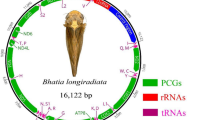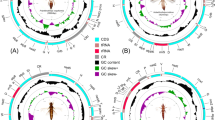Summary
Sequence comparisons were made for up to 667 bp of DNA cloned from 14 kinds of HawaiianDrosophila and five other dipteran species. These sequences include parts of the genes for NADH dehydrogenase (subunits 1, 2, and 5) and rRNA (from the large ribosomal subunit). Because the times of divergence among these species are known approximately, the sequence comparisons give insight into the evolutionary dynamics of this molecule. Transitions account for nearly all of the differences between sequences that have diverged by less than 2%; for these sequences the mean rate of divergence appears to be about 2%/Myr. In comparisons involving greater divergence times and greater sequence divergence, relatively more of the sequence differences are due to transversions. Specifically, the fraction of these differences that are counted as transversions rises from an initial value of less than 0.1 to a plateau value of nearly 0.6. The time required to reach half of the plateau value, about 10 Myr, is similar to that for mammalian mtDNA. The mtDNAs of flies and mammals are also alike in the shape of the curve relating the percentage of positions at which there are differences in protein-coding regions to the time of divergence. For both groups of animals, the curve has a steep initial slope ascribable to fast accumulation of synonymous substitutions and a shallow final slope resulting from the slow accumulation of substitutions causing amino acid replacements. However, the percentage of all sites that can experience a high rate of substitution appears to be only about 8% for fly mtDNA compared to about 20% for mammalian mtDNA. The low percentage of hypervariable sites may be a consequence of a functional constraint associated with the low content of guanine and cytosine in fly mtDNA.
Similar content being viewed by others
Abbreviations
- mtDNA:
-
mitochondrial DNA
- bp:
-
base pair(s)
- ND:
-
NADH dehydrogenase
- rRNA:
-
ribosomal RNA
- rDNA:
-
DNA encoding rRNA
- Myr:
-
million years
References
Aquadro CF, Kaplan N, Risko KJ (1984) An analysis of the dynamics of mammalian mitochondrial DNA sequence evolution. Mol Biol Evol 1:423–434
Beverley SM, Wilson AC (1982) Molecular evolution inDrosophila and higher Diptera. I. Micro-complement fixation studies of a larval hemolymph protein. J Mol Evol 18:251–264
Beverley SM, Wilson AC (1984) Molecular evolution inDrosophila and the higher Diptera. II. A time scale for fly evolution. J Mol Evol 21:1–13
Beverley SM, Wilson AC (1985) Ancient origin for Hawaiian Drosophilinae inferred from protein comparisons. Proc Natl Acad Sci USA 82:4753–4757
Bodmer M Ashburner M (1984) Conservation and change in the DNA sequences coding for alcohol dehydrogenase in sibling species ofDrosophila. Nature 309:425–430
Brown GG, Simpson MV (1982) Novel features of animal mtDNA evolution as shown by sequences of two rat cytochrome oxidase subunit II genes. Proc Natl Acad Sci USA 79:3246–3250
Brown WM (1983) Evolution of animal mitochondrial DNA. In: Nei M, Koehn RK (eds) Evolution of genes and proteins. Sinauer, Sunderland MA, pp 62–88
Brown WM (1985) The mitochondrial genome of animals. In: MacIntyre RJ (ed) Molecular evolutionary genetics. Plenum, New York, pp 95–130
Brown WM, George M Jr, Wilson AC (1979) Rapid evolution of animal mitochondrial DNA. Proc Natl Acad Sci USA 76: 1967–1971
Brown WM, Prager EM, Wang A, Wilson AC (1982) Mitochondrial DNA sequences of primates: tempo and mode of evolution. J Mol Evol 18:225–239
Carson HL (1976) Inference of the time of origin of someDrosophila species. Nature 259:395–396
Carson HL (1982) Evolution of Drosophila on the newer Hawaiian volcanoes. Heredity 48:3–25
Carson HL, Kaneshiro KY (1976)Drosophila of Hawaii: systematics and ecological genetics. Annu Rev Ecol Syst 7:311–345
Carson HL, Hardy DE, Spieth HT, Stone WS (1970) The evolutionary biology of the Hawaiian Drosophilidae. In: Hecht MK, Steere WC (eds) Essays in evolution and genetics in honor of Theodosius Dobzhansky. Appleton-Century-Crofts, New York, pp 437–543
Clary DO, Wolstenholme DR (1985a) The ribosomal RNA genes ofDrosophila mitochondrial DNA. Nucleic Acids Res 13:4029–4045
Clary DO, Wolstenholme DR (1985b) The mitochondrial DNA molecule ofDrosophila yakuba: nucleotide sequence, gene organization, and genetic code. J Mol Evol 22:252–271
Clary DO, Goddard JM, Martin SC, Fauron CM-R, Wolstenholme DR (1982)Drosophila mitochondrial DNA: a novel gene order. Nucleic Acids Res 10:6619–6637
de Bruijn MHL (1983)Drosophila melanogaster mitochondrial DNA, a novel organization and genetic code. Nature 304:234–241
DeSalle R, Giddings LV (1986) Discordance of nuclear and mitochondrial DNA phylogenies in HawaiianDrosophila. Proc Natl Acad Sci USA 83:6902–6906
DeSalle R, Giddings LV, Templeton AR (1986a) Mitochondrial DNA variability in natural populations of HawaiianDrosophila. I. Methods and levels of variability inD. silvestris andD. heteroneura populations. Heredity 56:75–85
DeSalle R, Giddings LV, Kaneshiro KY (1986b) Mitochondrial DNA variability in natural populations of HawaiianDrosophila. II. Genetic and phylogenetic relationships of natural populations ofD. silvestris andD. heteroneura. Heredity 56:87–96
Greenberg BD, Newbold JE, Sugino A (1983) Intraspecific nucleotide sequence variability surrounding the origin of replication in human mitochondrial DNA. Gene 21:33–49
Hennig W (1973) Diptera (Zweiflüger). In: Kükenthal W (ed) Handbuch der Zoologie IV:2:2:31. Arthropoda, Insecta, ed 2. W de Gruyter, Berlin, pp 1–337
Higuchi R, Bowman B, Freiberger M, Ryder OA, Wilson AC (1984) DNA sequences from the quagga, an extinct member of the horse family. Nature 312:282–284
Higuchi RG, Wrischnik LA, Oakes E, George M, Tong B, Wilson AC (1987) Mitochondrial DNA of the extinct quagga: relatedness and extent of post-mortem change. J Mol Evol 25:283–287
Holmquist R (1976) Solution to a gene divergence problem under arbitrary stable nucleotide transition probabilities. J Mol Evol 8:337–349
Holmquist R (1983) Transitions and transversions in evolutionary descent: an approach to understanding. J Mol Evol 19:134–144
HsuChen C-C, Koten RM, Dubin DT (1984) Sequences of the coding and flanking regions of the large ribosomal subunit RNA gene of the mosquito mitochondria. Nucleic Acids Res 12:7771–7785
Johnson WE, Carson HL, Kaneshiro KY, Steiner WWM, Cooper MM (1975) Genetic variation in Hawaiian Drosophila II. Allozymic differentiation in theD. planitibia subgroup. In: Markert CL (ed) Isozymes IV: genetics and evolution. Academic Press, New York, pp 563–584
Jukes TH (1982) Silent nucleotide substitutions in evolution. Presented at the Meeting of the Society for the Study of Evolution and The American Society of Naturalists, June 23, 1982, Stony Brook NY
Powell JR, Caccone A, Amato GD, Yoon C (1986) Rates of nucleotide substitution inDrosophila mitochondrial DNA and nuclear DNA are similar. Proc Natl Acad Sci USA 83:9090–9093
Solignac M, Monnerot M, Mounolou J-C (1986) Mitochondrial DNA evolution in themelanogaster species subgroup ofDrosophila. J Mol Evol 23:31–40
Swofford DL (1985) Phylogenetic analysis using parsimony (PAUP), version 2.4. Illinois Natural History Survey, Champaign IL
Topal MD, Fresco JR (1976) Complementary base pairing and the origin of substitution mutations. Nature 263:285–289
Vawter L, Brown WM (1986) Nuclear and mitochondrial DNA comparitions reveal extreme rate variation in the molecular clock. Science 234:194–196
Wilson AC, Cann RL, Carr SM, George M, Gyllensten UB, Helm-Bychowski KM, Higuchi RG, Palumbi SR, Prager EM, Sage RD, Stoneking M (1985) Mitochondrial DNA and two perspectives on evolutionary genetics, Biol J Linn Soc 26:375–400
Wolstenholme DR, Clary DO (1985) Sequence evolution ofDrosophila mitochondrial DNA. Genetics 109:725–744
Author information
Authors and Affiliations
Rights and permissions
About this article
Cite this article
DeSalle, R., Freedman, T., Prager, E.M. et al. Tempo and mode of sequence evolution in mitochondrial DNA of HawaiianDrosophila . J Mol Evol 26, 157–164 (1987). https://doi.org/10.1007/BF02111289
Received:
Revised:
Issue Date:
DOI: https://doi.org/10.1007/BF02111289




